A Project of the Hudson River Estuary Program
Compiled by Tom Lake, Consulting Naturalist
Overview
This was a very diverse week of special moments, including a second harbor seal, a persistent summer tanager, a blackbird “invasion,” and a banded bald eagle that, once again, reminded us how our watershed is touched by faraway places.
Highlight of the Week
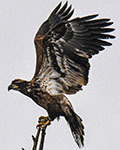 2/19 – Eastern Dutchess County, HRM 96: I had the good fortune to recently photograph a banded immature bald eagle. I sent the data from the burnt-orange band (0829-00103; 00/C) to the Massachusetts Division of Fisheries and Wildlife [Massachusetts bald eagle bands are burnt-orange]. 2/19 – Eastern Dutchess County, HRM 96: I had the good fortune to recently photograph a banded immature bald eagle. I sent the data from the burnt-orange band (0829-00103; 00/C) to the Massachusetts Division of Fisheries and Wildlife [Massachusetts bald eagle bands are burnt-orange].
The nestling (at the time) bald eagle had been banded on June 3, 2019, in Worcester County, Massachusetts. Based on its small size (6.75 pounds), it was thought to be a male. Its sibling (10.25 pounds) was thought to be a female. (Photo of banded bald eagle courtesy of Deborah Tracy Kral)
- Deborah Tracy Kral
Natural History Entries
2/15 – Newcomb, HRM 302: On four nights this past week, nighttime air temperatures fell to minus 20-24 degrees below zero. The river had been resisting a winter freeze, but this was certainly a catchup.
- Tom Lake
2/15 – Town of Wappinger, HRM 67.5: The sun had set, and dusk was turning to dark. Bald eagle nest NY459 was empty. One adult was perched on a nearby limb and the second in a tree near the river a few hundred feet away. Both were just black silhouettes. No incubation as yet.
- Tom Lake
2/15 – Constitution Marsh Sanctuary, HRM 52: In a cold, frozen winter, you would expect to see eagles in the trees rimming this tide marsh. But none were there today, a common scene this season. The eagles were elsewhere, father north and east. The marsh was partially frozen, and in the open water was a raft of ring-necked ducks (20-25). A short distance away was another raft of similar-size lesser scaup.
- Tom Lake
 2/16 – Warren County, HRM 245: I drove south through The Glen this morning and down along the Ice Meadows, a ten-mile-long reach of the Hudson River. After several nights of Arctic cold, the Ice Meadows were setting up. Frazil ice had come together to freeze the river over but leaving enough for an open channel to wind through the riverbed. (Photo of ice meadows courtesy of Mike Corey) 2/16 – Warren County, HRM 245: I drove south through The Glen this morning and down along the Ice Meadows, a ten-mile-long reach of the Hudson River. After several nights of Arctic cold, the Ice Meadows were setting up. Frazil ice had come together to freeze the river over but leaving enough for an open channel to wind through the riverbed. (Photo of ice meadows courtesy of Mike Corey)
-Mike Corey
[When frazil ice touches something underwater, a deadfall or a rock, it sticks. It builds from the sides and from the middle of the river and can eventually form dams, such is the case at the Ice Meadows where the ice can grow to near glacial proportions. This process adds to other river dynamics that are constantly moving sand, silt, gravel, and cobbles along the riverbed. Evelyn Greene]
[Mike Corey of Minerva, river mile 284 in the Adirondacks, is one of the original Hudson River Almanac contributors. Mike’s first entry came 25 years ago, on March 25, 1994, when at midnight he came upon a fisher (Pekania pennanti) nibbling on the remnants of a road-killed white-tailed deer on Route 28N in Essex County. Tom Lake]
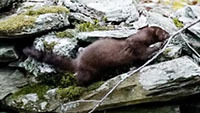 2/16 – Town of Clinton, HRM 98: While participating in the Great Backyard Bird Count today, I saw movement on a rock wall in our back yard – a chipmunk scurried off. Then I saw the reason, a mink. We see mink on rare occasions as they follow a seasonal creek that runs through our property. This one hunted for ten minutes and then moved on. (Photo of mink courtesy of Klaudia Frizzell) 2/16 – Town of Clinton, HRM 98: While participating in the Great Backyard Bird Count today, I saw movement on a rock wall in our back yard – a chipmunk scurried off. Then I saw the reason, a mink. We see mink on rare occasions as they follow a seasonal creek that runs through our property. This one hunted for ten minutes and then moved on. (Photo of mink courtesy of Klaudia Frizzell)
- Klaudia Frizzell
2/16 – Milan, HRM 90: Our local black bear was back! It looked to be in good condition with a grey muzzle. - Marty Otter
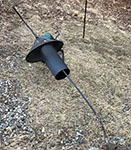 2/16 – Milan, HRM 90: Showing respect for the black bears, I've been taking our bird feeders in at night. However, with colder nighttime air temperatures hopefully tempering bear activity, I thought it was safe to leave them out last night. This morning I discovered that a midnight bear visit left one of our two iron shepherd’s hooks holding sunflower and seed feeders bent almost double – not its first attack on our shepherd’s hooks! Interestingly, the bear left the four other feeders and suet untouched. (Photo of black bear damage courtesy of Frank Margiotta) 2/16 – Milan, HRM 90: Showing respect for the black bears, I've been taking our bird feeders in at night. However, with colder nighttime air temperatures hopefully tempering bear activity, I thought it was safe to leave them out last night. This morning I discovered that a midnight bear visit left one of our two iron shepherd’s hooks holding sunflower and seed feeders bent almost double – not its first attack on our shepherd’s hooks! Interestingly, the bear left the four other feeders and suet untouched. (Photo of black bear damage courtesy of Frank Margiotta)
- Frank Margiotta (Ralph T. Waterman Bird Club)
[The DEC released a Guidance to Homeowners on how to avoid problems with black bears.
http://www.dec.ny.gov/press/113258.html]
2/16 – Cold Spring, HRM 55: We were walking our dog down by the Cold Spring waterfront when we spotted a seal. It was playful and making noise right by the dock. Reviewing our photos and a video, it looked like a harbor seal.
- Kevin Bierfeldt, Breana Negersth
[Harbor seals are one of four seal species found in the estuary, the other three are hooded seal, gray seal, and harp seal. While seals at a distance all look superficially the same, harbor seals are by far the most common. While seals can be found in the river at any time of the year, spring seems to be their peak as they arrive to feed on the enormous schools of shad and river herring that are migrating in from the sea to spawn. Tom Lake]
[To report a sick or injured marine mammal, please call the New York State 24-hour Hotline at (631) 369-9829. If you have photos or videos of live marine mammals, please send them to sightings@riverheadfoundation.org. If you have photos or videos of deceased marine mammals, please send them to sightings@amseas.org. Tom Lake]
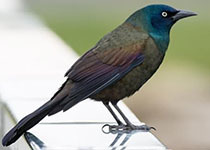 2/17 – New Paltz, HRM 76: Much like three days ago, this morning we had another blackbird visitation, but quite different from last Friday's red-winged spectacle. Today, common grackles dropped into the back yard in many small groups, mobbing the tube feeders and fanning out in the flower beds and lawn. They flipped over leaves, poked and scratched, hopping up to relocate here and there, with new groups filtering in and others walking away into the woods behind the yard, all the while creaking and squeaking and gleaming like gasoline on water in the morning sun. We couldn't figure out how to count them with all the comings and goings. Our best guess would be more than 1,000. We did see three red-winged blackbirds and two brown-headed cowbirds among them, but no starlings. (Photo of common grackle courtesy of Evan Lipton) 2/17 – New Paltz, HRM 76: Much like three days ago, this morning we had another blackbird visitation, but quite different from last Friday's red-winged spectacle. Today, common grackles dropped into the back yard in many small groups, mobbing the tube feeders and fanning out in the flower beds and lawn. They flipped over leaves, poked and scratched, hopping up to relocate here and there, with new groups filtering in and others walking away into the woods behind the yard, all the while creaking and squeaking and gleaming like gasoline on water in the morning sun. We couldn't figure out how to count them with all the comings and goings. Our best guess would be more than 1,000. We did see three red-winged blackbirds and two brown-headed cowbirds among them, but no starlings. (Photo of common grackle courtesy of Evan Lipton)
- Lynn Bowdery, Allan Bowdery
[In the 1990's, I helped in many archaeological investigations of the Wallkill River flood plain. We recovered evidence of an almost continuous human presence on the flood plain beginning more than 7,000 years ago (one small site dated to 12,000 years ago). I wonder if those hunters and gatherers passing along the Wallkill River witnessed the same spectacles and felt the same sense of awe? Tom Lake]
2/17 – Town of Poughkeepsie: A tenuous consensus among several of us (The Soul of NY62) has incubation beginning today for bald eagle nest NY62 – there were nest turnovers throughout the day. If our guess is right, we will look for a hatch around March 19-22.
- Debbie Quick, Bob Rightmyer
2/18 – Westchester County, HRM 46: We have several trail cameras with good views of our back yard in North Salem. We often see on these cameras a variety of wildlife traversing our yard at night, ones that you might never know were around if you only went by daylight observations.
On one recent early morning, well before sunrise, we had a bobcat amble across the yard. A little later in the morning there was a curious pair, a striped skunk and a red fox, walking near each other displaying no apparent aggression [a fox would see too much downside in considering a skunk as a meal]. Finally, we saw a coyote rolling like a dog, most likely scratching its back, as well as raccoons, wild turkeys, opossum, cottontail rabbits, and white-tailed deer. It is such a thrill to see the wildlife that lives in our neighborhood!
- Irene Marks
2/18 – Manitou, HRM 46.5: Over the last three days, checking the nest several times each day, there has been a continuous adult occupation of bald eagle nest NY527 with a second adult perched nearby. We have started the incubation “clock.” If we are correct, we may see a hatch around March 18-20. This pair fledged one nestling last year as a first-year nest, and we are hoping for another successful outcome this year.
- Owen Sullivan, Zshawn Sullivan
 2/19 – Mohawk River, HRM 157: We came across eight tundra swans at the confluence of the Mohawk River and Schoharie Creek, near the Schoharie Crossing boat launch. They were easily seen resting on the ice in company with some Canada Geese. (Photo of tundra swan courtesy of Diane McAllister) 2/19 – Mohawk River, HRM 157: We came across eight tundra swans at the confluence of the Mohawk River and Schoharie Creek, near the Schoharie Crossing boat launch. They were easily seen resting on the ice in company with some Canada Geese. (Photo of tundra swan courtesy of Diane McAllister)
- Marianne Friers (Hudson-Mohawk Bird Club)
[Tundra swans (Cygnus columbianus) are often called “America’s native swan.” Their common name refers to their summer nesting range north of Hudson Bay in the Arctic tundra. They can usually be heard calling long before they are seen, which leads to another frequently used colloquial name, “whistling swan.” David Sibley remarks that distant flocks sound like “baying hounds.” Tundra Swans are occasional visitors to the Hudson Valley during spring and fall migrations. Tom Lake]
*** Fish of the Week ***
 2/20 – Hudson River Watershed: Fish-of-the-Week for Week 59 is the longnose gar (Lepisosteus osseus), number 15 (of 230) on our watershed list of fishes. If you would like a copy of our list, e-mail - trlake7@aol.com. 2/20 – Hudson River Watershed: Fish-of-the-Week for Week 59 is the longnose gar (Lepisosteus osseus), number 15 (of 230) on our watershed list of fishes. If you would like a copy of our list, e-mail - trlake7@aol.com.
Gar have lived in North American waters for at least 50 million years. Fossil gar found in rocks from the Green River formation of western Wyoming are so similar to gar found today in New York waters that they are considered to be members of the modern genus Lepisosteus. Longnose gar is one of two species of their family, Lepisosteidae, found in the Hudson River watershed. The other is the alligator gar (L. osseus). Their presence in the watershed is supported by a single 30-inch fish found impinged on the intake screens at the Roseton Power Generating Facility (river mile 66.5) in Orange County in 1989. That gar was believed to have been a canal immigrant from Lake Champlain.
Longnose gar is a primitive-looking, extremely well adapted fish, whose evolutionary journey began several hundred million years ago. With a fusiform body, armor-like ganoid scales, long narrow jaws full of very sharp teeth, growing to six-feet-long, they have been described by zoologist Archie Carr as having a “Paleozoic leer.”
Longnose gar are primarily freshwater fishes, although they can live in coastal marine waters, and are found in eastern North America from Quebec to northern Mexico (their type site is Virginia). In New York State, they occur in relatively large lakes such as Lake George and Lake Champlain, as well as both Lake Erie and Lake Ontario. They are essentially piscivores (fishes) but have been known to eat blue crabs in brackish water. The New York State longnose gar angling record was set by Michael Gatus on Aug. 18, 2018, in South Bay of Lake Champlain, with a 14 pounds, 10 ounces, 52.25-inch-long fish.
A unique characteristic of gar is their ability to use atmospheric oxygen allowing them to live in low-oxygen conditions such as shallow, freshwater habitats associated with coastal wetlands. This is likely an evolutionary adaptation for survival in an aquatic world far different than today.
A longnose gar anecdote: On May 13, 1994, five dead longnose gar were recovered from an outwash area on the Saw Mill River in Yonkers (eight dead gar were reported there the day before). While it was possible that longnose gar were resident fish, albeit never reported there before, we viewed the likelihood with a great deal of skepticism.
June 1, 1994, a day-long investigation of the Saw Mill River watershed was conducted by Dr. C. Lavett Smith (Curator of Ichthyology, American Museum of Natural History), Dr. Bob Schmidt (Simon’s Rock College, Bard College), Christopher Letts (Hudson River Foundation), and Tom Lake. Using gill nets, dip nets, and seines, the exhaustive sampling resulted in a collection of eight rather unremarkable resident species, but no evidence of longnose gar.
Subsequent analyses of the stomach contents from five of the longnose gar, conducted by Norma Feinberg (Ichthyology Department, American Museum of Natural History), revealed partially digested striped bass and white catfish. In contemplating where the gar may have encountered these species, we considered several possibilities: Sawmill River, Hudson River, Lake Champlain, Lake Erie, and the Chesapeake Bay system.
After much consideration of the various physical, hydrological, and chemical components of each system, we concluded that at least five of the eight longnose were probably dumped in the Saw Mill River by an angler returning from a trip to the Chesapeake Bay area, possibly the Potomac River where longnose gar were common (Hildebrand and Schroeder 1928:78). In the end, they were not from the watershed, but their appearance gave us a wonderful mystery to unravel and a memorable educational journey. (Photo of longnose gar courtesy of David Figura)
- Tom Lake
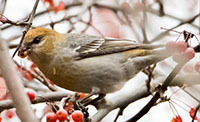 2/20 – Washington County, HRM 188: While traveling on Route 313 through Shushan today, I found one small flock of pine grosbeaks (eight birds) by the roadside in the Battenkill State Forest. I parked to watch them for five minutes and found a gorgeous adult male providing fantastic views on the lower boughs of a large white pine tree. (Photo of pine grosbeak courtesy of Sue Barth) 2/20 – Washington County, HRM 188: While traveling on Route 313 through Shushan today, I found one small flock of pine grosbeaks (eight birds) by the roadside in the Battenkill State Forest. I parked to watch them for five minutes and found a gorgeous adult male providing fantastic views on the lower boughs of a large white pine tree. (Photo of pine grosbeak courtesy of Sue Barth)
- Scott Varney (Hudson-Mohawk Bird Club)
2/20 – Saugerties, HRM 102: Our “resident” harbor seal, originally spotted at the mouth of Esopus Creek by Saugerties Lighthouse keeper Patrick Landewe on August 5, 2019, was seen again at dusk today. It was swimming in the mouth of Esopus Creek and catching fish (unknown species). The longevity of its visit had now reached 202 days.
- Patrick Landewe
 2/21 – Ulster County: Students from the Mount Elementary School in Esopus joined hundreds of students from across New York State to participate in the NYSDEC’s “We all live in a Watershed” poster contest. Although our students did not make the top selections, this was one of their wonderful entries. (Photo of recycle poster courtesy of Mario Meier) 2/21 – Ulster County: Students from the Mount Elementary School in Esopus joined hundreds of students from across New York State to participate in the NYSDEC’s “We all live in a Watershed” poster contest. Although our students did not make the top selections, this was one of their wonderful entries. (Photo of recycle poster courtesy of Mario Meier)
- Mario Meier
2/21 – Town of Wappinger, HRM 68: A female summer tanager (Piranga rubra), first spotted at our seed feeders on January 15, was still there this morning on Day 38. For Dutchess County, there are only three previous records of a summer tanager, and none in winter. Our first red-winged blackbirds were also here this morning. The summer tanager tends to chase away the goldfinches and recently has begun pushing the downy woodpeckers from their favorite feeder.
- Melissa Fischer, Stephen Fischer (Ralph T. Waterman Bird Club)
2/21 – East Fishkill, HRM 66: We had three dozen red-winged blackbirds in our yard today, our first of the year. We spotted them under our bird feeders eating seed that the blue jays had knocked onto the ground. I’m guessing that our black bears will be around soon.
- Diane Anderson
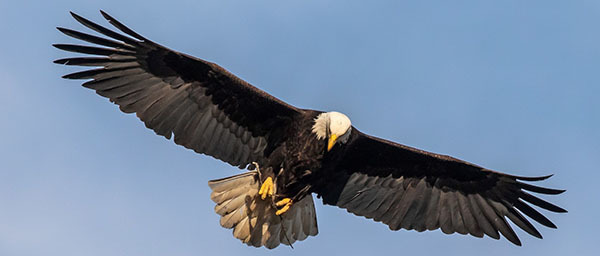
Winter 2019-2020 Natural History Programs
Wednesday, March 11, 2020 9:00 am - 4:00 pm (Snow Date Friday, April 10, 2020)
Studying Ecosystems of the Tidal Hudson
Norrie Point Environmental Center, Staatsburg, NY
The Hudson River National Estuarine Research Reserve invites you to attend Research in the Reserve 2020: Participate in an all-day forum on collaborative ecosystem research conducted with the Reserve or at its four tidal wetland sites along 100 miles of the Hudson Estuary.
https://www.hrnerr.org/hrnerr-research
March: Help Count Eels in Hudson River Tributaries
Are you looking for an outdoor volunteer opportunity? The DEC Hudson River Eel Project is seeking community members to help study eels in streams of the Hudson River estuary. The American eel (Anguilla rostrata), a migratory fish, is hatched in the Atlantic Ocean and enters North American estuaries, including the Hudson River, as tiny, see-through "glass eels" each spring.
As a volunteer, you will work in a team with scientists to collect these eels from specialized nets, count the fish one-by-one, weigh them in groups, and release them to habitat upstream. You will also help collect and record water temperature and water-quality data. Eels are counted in 15 streams from Staten Island to Troy. The field work takes place from March through May, and schedules are flexible. Training and all gear are provided. For more information, visit DEC's website or e-mail: eelproject@dec.ny.gov.
April: Trees for Tribs "Buffer in a Bag"
The New York State Department of Environmental Conservation’s statewide Trees for Tribs "Buffer in a Bag" application period is now open. The Buffer in a Bag initiative is designed to increase riparian buffers statewide by engaging landowners in small-scale plantings. Qualifying private and public landowners may apply for a free bag of 25 tree and shrub seedlings for planting near streams, rivers, or lakes to help stabilize banks, protect water quality, and improve wildlife habitat.
Anyone who owns or manages at least 50 feet of land along a stream or waterbody in New York State is eligible to receive a free bag of seedlings. Applicants are limited to one bag per property. All participants must provide photos and information indicating where the trees will be planted. There is a limited supply and recipients are selected first-come, first-served. Not sure if your site fits these criteria? Contact the Trees for Tribs program by calling (518) 402-9405 or emailing treesfortribs@dec.ny.gov.
Hudson River Miles
The Hudson is measured north from Hudson River Mile 0 at the Battery at the southern tip of Manhattan. The George Washington Bridge is at HRM 12, the Tappan Zee 28, Bear Mountain 47, Beacon-Newburgh 62, Mid-Hudson 75, Kingston-Rhinecliff 95, Rip Van Winkle 114, and the Federal Dam at Troy, the head of tidewater, at 153. The tidal section of the Hudson constitutes a bit less than half the total distance – 315 miles – from Lake Tear of the Clouds to the Battery. Entries from points east and west in the watershed reference the corresponding river mile on the mainstem.
To Contribute Your Observations or to Subscribe
The Hudson River Almanac is compiled and edited by Tom Lake and emailed weekly by DEC's Hudson River Estuary Program. Share your observations by e-mailing them to trlake7@aol.com.
To subscribe to the Almanac (or to unsubscribe), use the links on DEC's Hudson River Almanac or DEC Delivers web pages.
Discover New York State Conservationist - the award-winning, advertisement-free magazine focusing on New York State's great outdoors and natural resources. Conservationist features stunning photography, informative articles and around-the-state coverage. Visit the Conservationist webpage for more information.
Useful Links
National Oceanic and Atmospheric Administration online tide and tidal current predictions are invaluable when planning Hudson River field trips.
For real-time information on Hudson River tides, weather and water conditions from sixteen monitoring stations, visit the Hudson River Environmental Conditions Observing System website.
DEC's Smartphone app for iPhone and Android is now available at: New York Fishing, Hunting & Wildlife App.
Adventure NY
Under Governor Cuomo's Adventure NY initiative, DEC is making strategic investments to expand access to healthy, active outdoor recreation, connect more New Yorkers and visitors to nature and the outdoors, protect natural resources, and boost local economies. This initiative will support the completion of more than 75 projects over the next three years, ranging from improvements to youth camps and environmental education centers to new boat launches, duck blinds, and hiking trails. Read more about the Adventure NY initiative. For more information on planning an outdoor adventure in New York State, visit DEC's website at http://www.dec.ny.gov/outdoor.
Information about the Hudson River Estuary Program is available on DEC's website at http://www.dec.ny.gov/lands/4920.html.
|


 2/19 – Eastern Dutchess County, HRM 96: I had the good fortune to recently photograph a banded immature bald eagle. I sent the data from the burnt-orange band (0829-00103; 00/C) to the Massachusetts Division of Fisheries and Wildlife [Massachusetts bald eagle bands are burnt-orange].
2/19 – Eastern Dutchess County, HRM 96: I had the good fortune to recently photograph a banded immature bald eagle. I sent the data from the burnt-orange band (0829-00103; 00/C) to the Massachusetts Division of Fisheries and Wildlife [Massachusetts bald eagle bands are burnt-orange]. 2/16 – Warren County, HRM 245: I drove south through The Glen this morning and down along the Ice Meadows, a ten-mile-long reach of the Hudson River. After several nights of Arctic cold, the Ice Meadows were setting up. Frazil ice had come together to freeze the river over but leaving enough for an open channel to wind through the riverbed. (Photo of ice meadows courtesy of Mike Corey)
2/16 – Warren County, HRM 245: I drove south through The Glen this morning and down along the Ice Meadows, a ten-mile-long reach of the Hudson River. After several nights of Arctic cold, the Ice Meadows were setting up. Frazil ice had come together to freeze the river over but leaving enough for an open channel to wind through the riverbed. (Photo of ice meadows courtesy of Mike Corey) 2/16 – Town of Clinton, HRM 98: While participating in the Great Backyard Bird Count today, I saw movement on a rock wall in our back yard – a chipmunk scurried off. Then I saw the reason, a mink. We see mink on rare occasions as they follow a seasonal creek that runs through our property. This one hunted for ten minutes and then moved on. (Photo of mink courtesy of Klaudia Frizzell)
2/16 – Town of Clinton, HRM 98: While participating in the Great Backyard Bird Count today, I saw movement on a rock wall in our back yard – a chipmunk scurried off. Then I saw the reason, a mink. We see mink on rare occasions as they follow a seasonal creek that runs through our property. This one hunted for ten minutes and then moved on. (Photo of mink courtesy of Klaudia Frizzell) 2/16 – Milan, HRM 90: Showing respect for the black bears, I've been taking our bird feeders in at night. However, with colder nighttime air temperatures hopefully tempering bear activity, I thought it was safe to leave them out last night. This morning I discovered that a midnight bear visit left one of our two iron shepherd’s hooks holding sunflower and seed feeders bent almost double – not its first attack on our shepherd’s hooks! Interestingly, the bear left the four other feeders and suet untouched. (Photo of black bear damage courtesy of Frank Margiotta)
2/16 – Milan, HRM 90: Showing respect for the black bears, I've been taking our bird feeders in at night. However, with colder nighttime air temperatures hopefully tempering bear activity, I thought it was safe to leave them out last night. This morning I discovered that a midnight bear visit left one of our two iron shepherd’s hooks holding sunflower and seed feeders bent almost double – not its first attack on our shepherd’s hooks! Interestingly, the bear left the four other feeders and suet untouched. (Photo of black bear damage courtesy of Frank Margiotta) 2/17 – New Paltz, HRM 76: Much like three days ago, this morning we had another blackbird visitation, but quite different from last Friday's red-winged spectacle. Today, common grackles dropped into the back yard in many small groups, mobbing the tube feeders and fanning out in the flower beds and lawn. They flipped over leaves, poked and scratched, hopping up to relocate here and there, with new groups filtering in and others walking away into the woods behind the yard, all the while creaking and squeaking and gleaming like gasoline on water in the morning sun. We couldn't figure out how to count them with all the comings and goings. Our best guess would be more than 1,000. We did see three red-winged blackbirds and two brown-headed cowbirds among them, but no starlings. (Photo of common grackle courtesy of Evan Lipton)
2/17 – New Paltz, HRM 76: Much like three days ago, this morning we had another blackbird visitation, but quite different from last Friday's red-winged spectacle. Today, common grackles dropped into the back yard in many small groups, mobbing the tube feeders and fanning out in the flower beds and lawn. They flipped over leaves, poked and scratched, hopping up to relocate here and there, with new groups filtering in and others walking away into the woods behind the yard, all the while creaking and squeaking and gleaming like gasoline on water in the morning sun. We couldn't figure out how to count them with all the comings and goings. Our best guess would be more than 1,000. We did see three red-winged blackbirds and two brown-headed cowbirds among them, but no starlings. (Photo of common grackle courtesy of Evan Lipton) 2/19 – Mohawk River, HRM 157: We came across eight tundra swans at the confluence of the Mohawk River and Schoharie Creek, near the Schoharie Crossing boat launch. They were easily seen resting on the ice in company with some Canada Geese. (Photo of tundra swan courtesy of Diane McAllister)
2/19 – Mohawk River, HRM 157: We came across eight tundra swans at the confluence of the Mohawk River and Schoharie Creek, near the Schoharie Crossing boat launch. They were easily seen resting on the ice in company with some Canada Geese. (Photo of tundra swan courtesy of Diane McAllister) 2/20 – Hudson River Watershed: Fish-of-the-Week for Week 59 is the longnose gar (Lepisosteus osseus), number 15 (of 230) on our watershed list of fishes. If you would like a copy of our list, e-mail -
2/20 – Hudson River Watershed: Fish-of-the-Week for Week 59 is the longnose gar (Lepisosteus osseus), number 15 (of 230) on our watershed list of fishes. If you would like a copy of our list, e-mail -  2/20 – Washington County, HRM 188: While traveling on Route 313 through Shushan today, I found one small flock of pine grosbeaks (eight birds) by the roadside in the Battenkill State Forest. I parked to watch them for five minutes and found a gorgeous adult male providing fantastic views on the lower boughs of a large white pine tree. (Photo of pine grosbeak courtesy of Sue Barth)
2/20 – Washington County, HRM 188: While traveling on Route 313 through Shushan today, I found one small flock of pine grosbeaks (eight birds) by the roadside in the Battenkill State Forest. I parked to watch them for five minutes and found a gorgeous adult male providing fantastic views on the lower boughs of a large white pine tree. (Photo of pine grosbeak courtesy of Sue Barth) 2/21 – Ulster County: Students from the Mount Elementary School in Esopus joined hundreds of students from across New York State to participate in the NYSDEC’s “We all live in a Watershed” poster contest. Although our students did not make the top selections, this was one of their wonderful entries. (Photo of recycle poster courtesy of Mario Meier)
2/21 – Ulster County: Students from the Mount Elementary School in Esopus joined hundreds of students from across New York State to participate in the NYSDEC’s “We all live in a Watershed” poster contest. Although our students did not make the top selections, this was one of their wonderful entries. (Photo of recycle poster courtesy of Mario Meier)